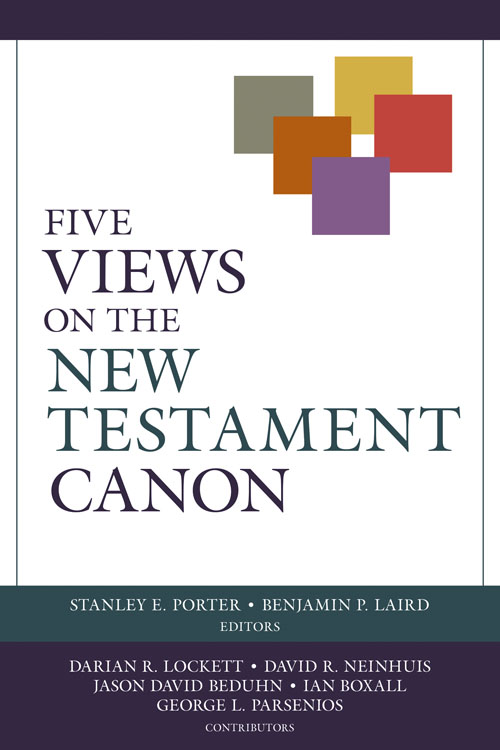
Editor’s note: This post originally appeared on Think Apologetics. Tabernacle of David considers this resource trustworthy and Biblically sound.
.

Five Views on the New Testament Canon by Stanley E. Porter, 304 pp. Kregal Publications, 2018.
The word “canon” comes from the rule of law that was used to determine if a book measured up to a standard. There have been more than enough books (on both Testaments) that discuss the measure or standard was used to determine which books should be classified as Scripture.
In this book, each author discusses the historical, political, and ecclesial realities that drove the canonization of the New Testament as well as how the doctrines of Early Christianity are related to the formation of the New Testament. They also discuss whether the New Testament differs in authority from other early Christian texts.
Whereas many books on canon are written by one author, this book features five different authors who address these topics. The different perspectives presented are from the following authors:
1.A Conservative Evangelical Perspective — Darian R. Lockett
2. A Progressive Evangelical Perspective — David R. Nienhuis
3.A Liberal Protestant Perspective — Jason David BeDuhn
4.A Roman Catholic Perspective — Ian Boxall
5.An Orthodox Perspective — George L. Parsenios
While I mostly identify with Lockett’s position, all five of the positions presented in the book agree that there is a New Testament canon that consists of twenty-seven books. The process of recognition may or may not have been formally established, but so far as these ecclesial traditions are concerned, there is a New Testament canon. Also, some of the books within this canon may have taken longer amounts of time to become recognized, and they have been variously ordered at times within the tradition of their transmission, based upon a range of possible factors. It would also seem highly likely that these books were first grouped together into sub-corpora or subcollections before they came to be joined together as what we now recognize as the canon of authoritative writings. All the authors also agree that human involvement occurred at some stage in the process, although the amount and type of human involvement is debated. Finally, all the positions represented here agree that the New Testament canon has some form of abiding and normative value and function within the Christian church, although the source and type of this normativity often varies from tradition to tradition- Pgs 254-255.
Both the Roman Catholic and Orthodox positions have numerous similarities, even if one position can point to a date of canonical finality while the other cannot. Nevertheless, one might be surprised to see that the conservative evangelical position and the progressive evangelical position have several major differences in approach and orientation. As a result, the conservative evangelical position has some striking similarities with the liberal Protestant view concerning the historical process, while the progressive evangelical view has several similarities with the Roman Catholic and Orthodox positions regarding the role and influence of tradition.-pgs, 255-256.
Within each view, there is disagreement over a variety of factors. This disagreement includes the date at which such a canonical text can be said to exist, how this recognition occurred, and the implications of these conclusions. Here the range of disagreement is large. All the positions, apart possibly from the conservative evangelical view, believe that the process by which the canonical text came to be was one that involved noncanonical criteria, for the most part revolving around a variety of historical factors within the life of the Christian church. In other words, most of the positions, and even the conservative evangelical view in that it sees the two as in harmony, argue that one can arrive at a canonical text by means of discussing it as a historical text.
The conservative evangelical position seems to equate a historical, theological, and canonical text, or at least an incipient canonical text, as coterminous with the authorial text, that is, the text as authored by the biblical writer. The other authors with different positions criticize the conservative evangelical view for this very reason. The result for this position is that the canonical text is associated with a particular view of historicity and theological relevance that the other positions do not necessarily share, but that is necessarily insisted upon by this position.- pg 262.
One thing that stands out is that there is a fundamental difference of opinion on the nature of the New Testament, that is, what kind of text it is. One of the reasons that the authors disagree is that they have different views of text, and because of this they are asking different questions of the text and expecting different answers. There are three types of text of relevance. The first is theological texts, and this is a category that is clearly operative in our discussion of the canon in this volume. However, there are also historical texts and canonical texts. A historical text is a text that is defined by its purporting to represent and depict a historical process and it is mostly used by those interested in questions of historical reconstruction and determining historical knowledge. A canonical text is a text that is defined as a text recognized for being authoritative within its respective sphere of functionality.
As you can see, trying to discuss canon between the various traditions represented here is complex. If one doesn’t have a high interest in hearing how each tradition has formed their views of canon, this is not the book for you. If you want to read books that treat canon as an apologetic issue (such as Michael’s Kruger’s responses to Bart Ehrman), than that is what you need to be reading.
This book is somewhat technical. While it is informative, I think I prefer some other books I have on the topic.

